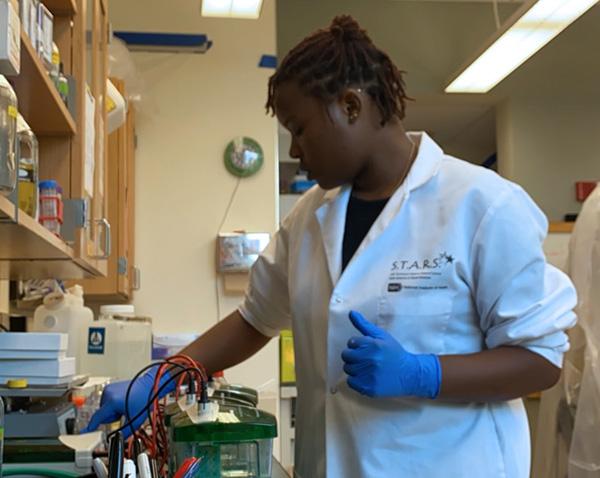Student Project Profile
Investigating Neuronal Cell Death in a Huntington’s Cell Model
Project Title
Chlorpyrifos induces neuronal cell death in a Huntington’s cell model via a mitochondria dependent pathway
Faculty Mentor(s)
Project Description

Our lab uses a cell model to investigate the role of the environment in combination with genetic factors in the progression of neurodegenerative disorders. This concept, called the gene-environment or nature-nurture interaction, suggests that human phenotypes and diseases are a result of their genes and the surroundings they exist in. This summer, I explored the effects of a commonly used pesticide called chlorpyrifos on a Huntington’s Disease (HD) cell model. The premise of my research was a 2017 study that my mentor conducted with former students which established that chlorpyrifos exposure exacerbated neurodegeneration in HD. My project was focused on identifying the specific molecular mechanisms that chlorpyrifos employed in facilitating neurodegeneration in Huntington’s Disease. The results from my research reveal a key underlying cellular mechanism of chlorpyrifos-induced neurodegeneration in HD and suggest potential therapeutic targets to combat chlorpyrifos in Huntington’s Disease patients.
How long have you been conducting research?
My work with Professor G. Kwakye started in the Fall of 2021 when I took his independent research lab for credit though I was working on a different project. I also conducted research with him in January of 2022 as part of the STRONG Winter Term Research Project. This summer (2023) was particularly immersive and enriching since I wasn’t simultaneously juggling classes together with the research.
Why is your research important?
The results from my research will help us suggest potential therapeutic targets to combat chlorpyrifos induced neurodegeneration in Huntington’s Disease patients. Chlorpyrifos is widely used in agricultural, industrial and domestic settings and establishing its neurotoxicity will also help to educate at-risk demographic groups who are persistently exposed to chlorpyrifos and advocate for policies requiring use of safer pesticides and tighter restrictions on the use of toxic ones such as chlorpyrifos.
What does the process of doing your research look like?
The lab is a cellular and molecular lab meaning we work with cells so most of the work is microscopic. In the lab, we culture cells, expose them to various concentrations of chlorpyrifos at different time points then conduct assays to assess how chlorpyrifos is affecting different facets of their health and metabolism. We usually measure cell death, cell viability, mitochondrial health and ATP production as well as protein expression using a number of established scientific techniques.
What knowledge has your research contributed to your field?
The results from my research reveal a key underlying cellular mechanism of chlorpyrifos-induced neurodegeneration in HD and suggest potential therapeutic targets to combat chlorpyrifos in Huntington’s Disease patients.
In what ways have you showcased your research thus far?
I have presented my research at the Undergraduate Research Symposium as well as the Oberlin Summer Research Symposium. My hope is that if I continue to work on this project, under the mentorship of Professor Kwakye, we can compile substantial findings and publish a paper.
How did you get involved in research? What drove you to seek out research experiences in college?
The emphasis on undergraduate research at Oberlin was one of my reasons for applying and coming to Oberlin. I was fortunate to be a part of the STRONG program whose aim is to increase access to resources for marginalized students in STEM. STRONG gave me an early introduction to research through the Research and Reasoning First Year Seminar and also connected me to a mentor based off of my interests as early as freshman year.
What is your favorite aspect of the research process?
I especially enjoy the literature review and the data analysis of my research because it reminds me of the potential for impact that my project has. I’m passionate about health equity and I hope to contribute to narrowing the health disparities so that marginalized communities and groups can have access to good quality health and also be informed of the health risks of things they are exposed to on a daily basis. Thinking about how my research fits into the bigger picture during data analysis and literature review makes the implications of my research more tangible and substantial to me.
How has working with your mentor impacted the development of your research project? How has it impacted you as a researcher?
My mentor is very supportive and encouraging and this has helped boost my confidence when conducting experiments and presenting my research. My mentor’s constructive criticism has sharpened my critical thinking skills and problem solving skills. It was nice to work in an environment where I was trusted enough to handle things by myself while being encouraged to ask questions and also being assured that it was okay to make mistakes.
How has the research you’ve conducted contributed to your professional or academic development?
The research has helped me hone certain techniques such as Western Blotting and Cell culture which will be useful if I pursue a career in this field of research. In addition, I’ve learnt to use various softwares for data analysis such as GraphPad Prism, SPSS and Microsoft Office Suit. My summer research has given me a sample of what it might be like to work in a research lab outside of Oberlin- a very important thing because it’s gotten me thinking about how to navigate a professional workplace, communicate with my supervisors, and establish boundaries.
What advice would you give to a younger student wanting to get involved in research in your field?
Don’t be afraid to approach professors with research ideas or to ask them for mentorship. If you’re in STEM, attend Lab Crawl and the research symposiums because it can help you narrow down the specific research you’re interested in in your field. Also, it’s never too early to start seeking out research opportunities, freshman year winter term can be a good time to dip your foot into research before you decide to pursue it or not!
Students

Tsitsi Zana ’24
fourth-year- Major(s):
- Neuroscience, Creative Writing, concentration in Global Health